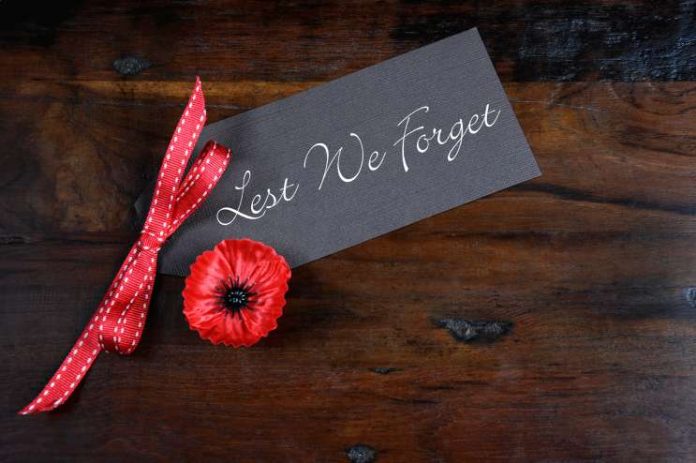What is the cost of freedom?
In Canada, we are fortunate to carry on our day-to-day lives with the greatest of freedoms and opportunities. How often do we stop and wonder why or what has enabled us to have this great freedom and opportunity? Is this something we take for granted, as a given?
It is Remembrance Day once again. A time to reflect. A time to think of our freedom.
Today Canadians take pause in their lives to reflect upon those who laid down their lives and bodies so that we can live a life of freedom and equality. For those that crossed seas to distant lands they did not know and from which they never returned.
Nor should we forget those who returned home from wars, alive but never to be the same again perhaps crippled or wounded or shattered emotionally from the horrors they endured.
As Canadians, we should be proud of our history of defending rights and freedoms. Not only ours but also the rights and freedoms of those in nations around the world. This has become part of our legacy.
Remembrance Day has become that one day that defines Canada like no other day. That day that symbolizes when many brave-hearted Canadians, of every race, or colour, and creed, joined as one to fight and protect us, even though they never would know us, nor would we ever know them.
Remembrance Day began after World War 1, with the signing of an agreement, the Armistice of Compiègne that put an end to fighting between the European Allies (of which Canada was heavily involved because of our membership in the British Dominion) and Germany. Fighting continued up to 11 a.m. on the 11th of November 1918. Tragically, even on that last day, 2,738 men died.
That moment is now frozen in time as a Day of Remembrance. A memorial day to honour those who have died in the line of duty. It is symbolized by wearing a poppy, a flower that grows wild in fields of western France where so many battles were fought and so many lives lost during WW1.
Ironically WW1 was called “The Great War” and “The war to end all wars”, a war in which over 20 million died and 21 million were wounded. But as we know, it would not be the end of wars.
More than 650,000 Canadians and Newfoundlanders served overseas in Europe. Over 66,000 of our service members gave their lives and more than 172,000 were wounded. At the Vimy Memorial in France, there are 378 Canadians buried, and the names of the 11,285 Canadian who lost their lives in France and had no known grave are recorded on the monument’s base.
Tragically the War to End all Wars led the way to yet another great war, just 21 years later, in which Canada played a large part.
During WW2, over 1.1 million Canadians served in the Canadian, Army, Navy, and Airforce. Approximately Canadians 42,000 died and another 55,000 wounded. Unknown are the numbers who returned home and were never the same again, living in constant anguish due to the horrors they witnessed or endured.
World War 2 was the deadliest conflict of all time. Between 70 and 85 million people died. Civilian deaths mounted to over 50 million and were double that of military deaths. It is impossible to know the number of lives scarred and never the same again after WW2.
By the war’s end, Canada had the world’s third-largest navy and fourth-largest allied airforce. Since then Canadians have continued to fight to preserve freedom and justice around the world.
The Korean War (1950-1953) claimed 516 Canadian lives and wounded more than 1,200.
The conflict in Bosnia (1992-1995) killed 20 Canadians and wounded an unknown number.
During the Afghanistan War (2001-2021) more than 40,000 Canadian Armed Forces members served and 158 Canadian soldiers died. Thousands of veterans of the war were wounded physically and psychologically. Some have later died by suicide.
War’s casualties are often numbered in terms of lives, lost or wounded. Only recently have we begun to associate the mental stress and trauma of those that have been to war but are scarred emotionally. We have become familiar with the term PTSD, post-traumatic stress disorder.
The terminology first came into use describing the mental health issues of American soldiers returning home in the 1970s from the Vietnam War. But it was originally named “shell shock” by British doctors beginning in WW1, and then again in WW2.
PTSD is defined as a psychological response to the experience of intense traumatic events, particularly those that threaten life. Traumatic stress is part of a normal human response to intense experiences. For the majority of people, the symptoms reduce or disappear over the first few months, particularly with the help of caring family members and friends. In a significant minority, however, the symptoms do not seem to resolve quickly and, in some cases, may continue to cause problems for the rest of the person’s life.
It is known that a significant number of Canadian soldiers returning from Afghanistan and Bosnian have been diagnosed with PTSD.
Sometimes the greatest damage caused by war is to the lives of the survivors.
For all our contributions on the battlefront in wars of the last century or more, we, as Canadians, are not known to be a combative nation. We are instead haled as being “Peacekeepers of the world.”
Following WW2, the United Nations asked member nations to contribute service personnel to help stabilize conflict zones by enforcing ceasefires and preventing small conflicts from escalating. Since then Canadian military, police officers, and civilian experts have been praised as peacekeepers who have worked to maintain peace and security, protect human rights, and help restore the rule of law.
Remembrance Day is not an easy day, it is not supposed to be. I for one, am immensely proud and so very thankful for all of those that fought and gave unselfishly for us. The cost of freedom seems so very high, and the amount of thanks, never seems enough.



















